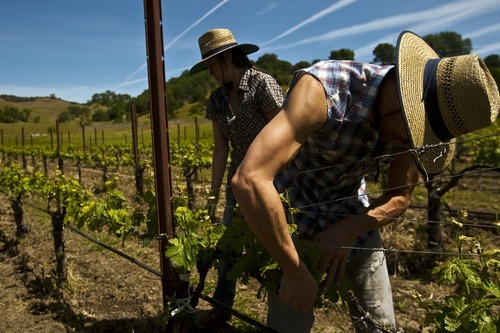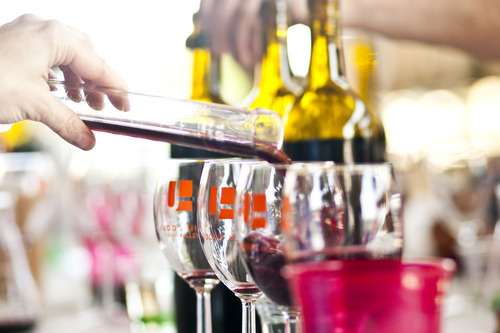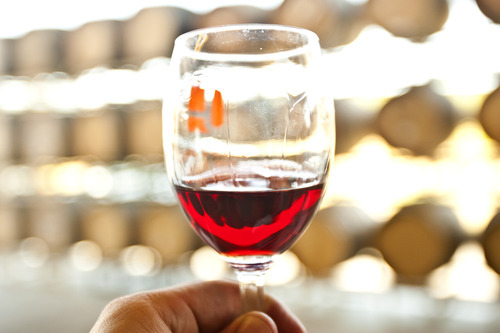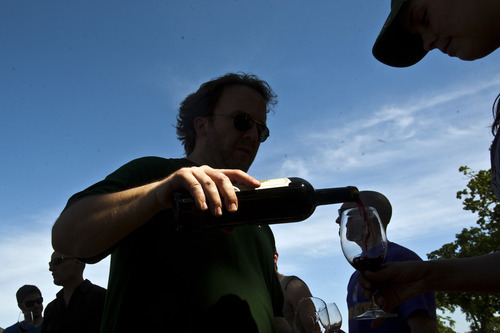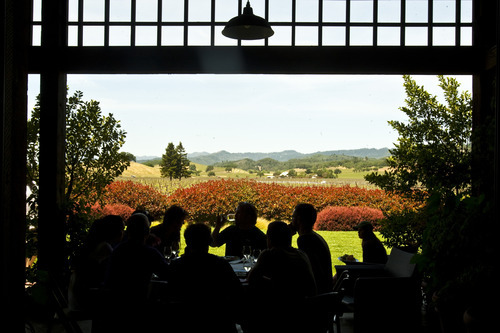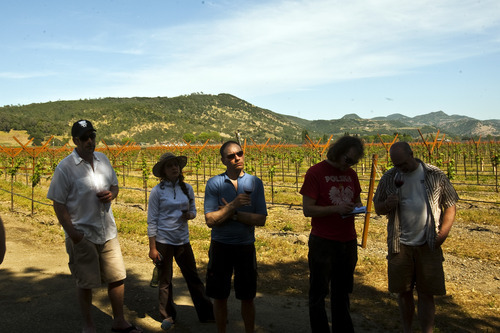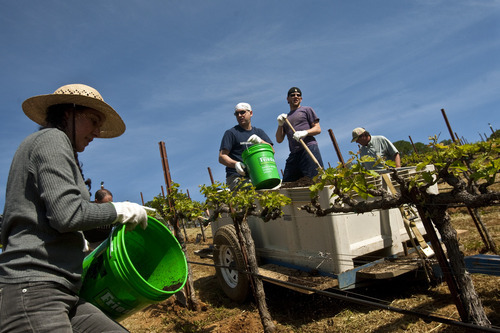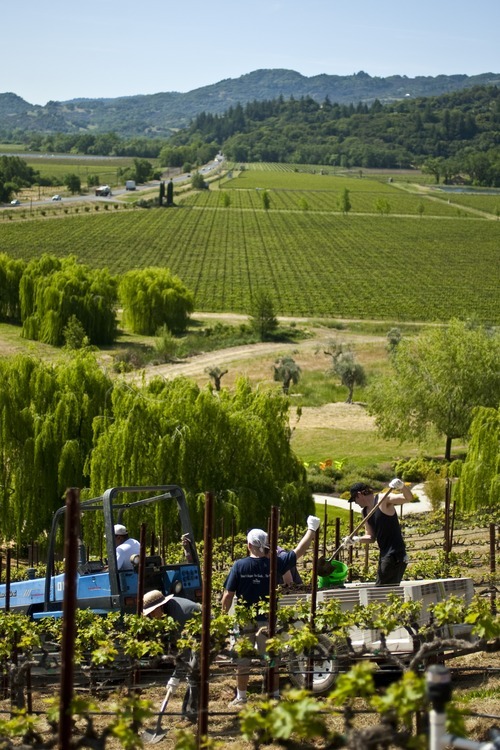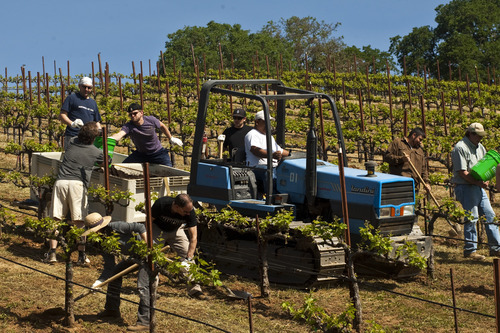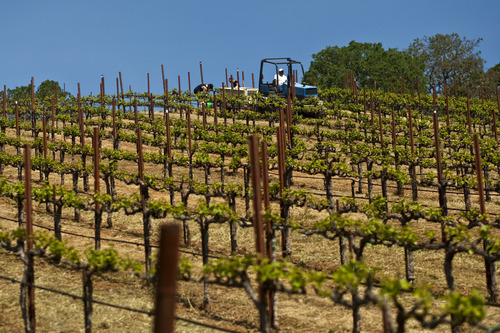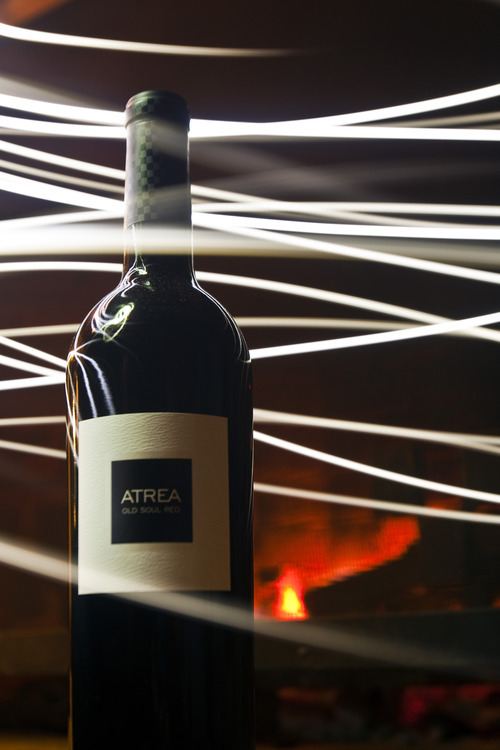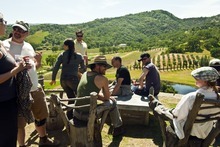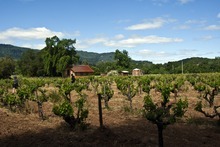This is an archived article that was published on sltrib.com in 2011, and information in the article may be outdated. It is provided only for personal research purposes and may not be reprinted.
Chris Buehler's lower back aches. Jon Keddington's right arm has a baseball-size bruise, and Chris Neidiger is nursing a sunburn.
These are the painful — yet welcome — wounds that Utah restaurant employees endure at Farm Camp, a four-day educational trip where they experience every aspect of winemaking. They haul compost, prune vines, talk to producers and, of course, sample wine. Their hard work and hands-on lessons ultimately pay off in better wine service for Utah diners and an improved bottom line for their employers.
Spring camp 2011 took place the first week of May, with a crew of 14 workers from nine Salt Lake City and Park City restaurants.
"It's physically difficult," said Buehler, a manager at Market Street Broiler in Salt Lake City, "but at the same time, it's a great environment."
Adds Keddington, also of Market Street: "It makes me want to be a farmer."
—
In the field • But wine making isn't glamorous, John Fetzer tells the group gathered on a recent morning in front of the Saracina, the winery he and his wife, Patty Rock, own in Mendocino County, Calif. "It's a lot of hard work. Kind of like the restaurant business."
Wearing torn jeans, old T-shirts and work boots, campers are ready to dig into the dirt at the 700-acre winery named after a village in Tuscany. Saracina follows many organic practices, including turning old grapes, vines, leaves and animal manure from nearby farms into rich compost to fertilize the fields.
On this day, half of the Utah group will add this rich, black compost to the soil where Zinfandel grapes grow.
The compost is added mechanically in other parts of the vineyard, explains Rob Carrillo the vineyard manager, but these vines are on a slope that's too steep for equipment. So the work must be done by hand with buckets, shovels and muscle.
"I came to learn about the viticulture," said Scott Wise, a waiter at Spruce in Park City. "And you can't do that unless you get your hands and feet dirty."
And they do. Under the bright California sun, they shovel the compost into large green buckets, pour it into freshly dug holes at the base of each vine and then cover it with dirt to ensure that the nitrogen reaches the roots. Carrillo supervises the group, showing them how to work more efficiently and pointing out when a hole is left empty or needs additional compost.
"It really shows people a small part of what we do," he said.
About a half mile away, in an area where Rousseau grapes are grown, the rest of the group thins vines, a process called "suckering." Removing excess or unhealthy looking leaves and stems opens up the canopy, allowing sun and air to circulate. It also prevents mildew and allows the plant to focus all its energy into producing luscious fruit, explains Alex MacGregor, Saracina's winemaker.
This year, due to cool weather and rain, the Roussane grapes are about two weeks behind schedule. "They are going to need all the help they can get," he said.
Initially, removing healthy leaves and stems just doesn't sit well with Chris Neidiger, a server at Silver in Park City. "I never would have thought pulling them off would actually help."
But soon the angst is gone and the work — performed in such picturesque surroundings — becomes almost therapeutic. "It's like bonsai work, very meditative," said Amanda Plutswik, a bartender at the Metropolitan.
At the end of the day everyone is sweaty, dirty and tired, but satisfied.
"I like that we're not just going from winery to winery for tastings," said Jessica Peterson, from Spruce. "We're actually getting to touch the vines and the dirt."
—
A green education • This kind of hands-on work is why Francis Fecteau started Farm Camp four years ago. The Utah wine broker, owner of Libations Inc., has numerous wines from organic and sustainable farms in his portfolio. "For a long time, I couldn't sell green wine with a gun, even though it tasted better and lasted longer and aged better," he said.
As part of his job, Fecteau spends time working on the vineyards and talking to wine owners. He's impressed by the care that is put into growing the grapes, something he insists wine drinkers can taste in the finished product. "I wanted others in the industry to experience it the way that I got to," he said.
He patterned Farm Camp after similar programs in Oregon and Washington state, with a focus on small sustainable vineyards. The camp is now offered twice a year in the spring and fall.
During the four days, the group travels to Napa, Mendocino and Sonoma counties, spending time at several wineries all of which have wines in Utah restaurants and state wine stores. (See the list that accompanies this story.)
Anyone associated with a Utah restaurant can attend, and past campers have included everyone from chefs and restaurant owners to managers and servers. Participants pay transportation costs to and from California, but stay in housing available on the vineyards.
While the trips obviously help increase sales for Fecteau, employers such as Ethan Lappe, of Caffe Niche in Salt Lake City, said the experience is mutually beneficial, providing the type of wine training that's just not possible at a sit-down class.
"I've spent time in Napa and seen the wine-making process," Lappe said. "It really does give you good talking points and creates a real story for the bottle of wine."
Today's wine-savvy consumers seem to appreciate the knowledge. For example, since server Jason Weiner returned from Farm Camp, he's more confident talking about wine with customers and his individual bottle sales have increased significantly. "It makes more money for him in tips, but also for the restaurant," Lappe said.
—
Science class • Rather than giving the usual wine tours and tasting, Judd's Hill, a certified green winery located at the southern end of Napa Valley's famous Silverado Trail, offers blending classes to guests.
"I like to turn people on to this aspect of winemaking," said Judd Finkelstein, whose parents, Bunny and Art, began making wine in the 1970s. "It shows how wine gets its depth and complexity."
He compared it to an artist adding different shades of color to a painting: "It's taking new components and making something elegant out of it."
After arriving at Judd's Hill, the Utah group gathered around a long table covered with butcher paper and set with a strange mix of glasses, bottles, beakers, measuring tubes and calculators.
Finkelstein said the wines at the table — siphoned that morning from oak barrels — are still immature and not ready for bottling, but are perfect for his blending experiments. He tells the group to sample each wine, jot down their impressions and then decide how they might be blended.
"It's just like being in the kitchen where you add a spice here and a spice there," said Finkelstein. "Once you start putting things together, it's magical."
Soon the table resembles science class as campers meticulously pour red wines into measured beakers. Some are going heavy with Cabernet Sauvignon; others prefer more Merlot or Cabernet Franc. "After tasting the wines, I had an idea in my head what I wanted to make," said Tim Ward, a waiter at Park City's 350 Main. "I wanted it to be Cab heavy."
By the time he was done adding more of this and less of that, "it was completely different," Ward said, settling on a blend of 75 percent Merlot, 10 percent Cabernet and a touch of Cab Franc.
—
Meet the maker • You can't really attend a wine camp without drinking some wine. Throughout the trip, the Utah group sipped dozens of different offerings, many glasses made more memorable because their owners were on hand to talk about their history and farming philosophies
At Honig winery, for instance, rather than making a dozen different wines from several different grapes, Michael and Stephanie Honig produce only two: Sauvignon Blanc and Cabernet Sauvignon.
"It allows us to focus on making great wine," said Michael Honig, a third-generation winemaker who took over the family business at 21 while he was still in college. The Honigs are dedicated to sustainable practices, implementing everything from solar power to lighter bottles that reduce shipping costs. Their efforts have even gone as far as training dogs to find certain detrimental bugs in the vineyard.
On the last day, the Utahns tour the Bucklin Vineyard in Glen Ellen. A portion of the vineyard, known as Old Hill Ranch, has Zinfandel vines that date back to the mid-1800s. Before it became prized as a wine grape, Zinfandel was actually a table grape and was planted during the lucrative Gold Rush era, explained winemaker Will Bucklin.
With his graying beard and plaid shirt, the 50-year-old Bucklin seems like a character straight out of the old West. He clearly is as unconventional as his vineyard, which happens to be one of the few California vineyards that is dry-farmed, surviving on natural rainfall and no added irrigation water.
While conventional farming is all about manipulation, dry farming is different. "Dry farming is all about live-and-let-live, but dry-farmed vines have good health," he said.
The proof is in the wine. A portion of the Zinfandel grapes from Old Hill Ranch are sold to the large wine producer, Ravenswood, for use in its award-winning, and pricey, Old Hill Ranch Zinfandel. In Utah, the wine sells for about $60 a bottle. Bucklin also reserves some of those same Old Hill Zinfandel grapes for his own label, which in Utah sells for $25 a bottle.
That kind of insider knowledge will be shared by farm campers back in Utah.
"It's really good to see the person making the wine," said Jason Horn, a manager at Alta's The Shallow Shaft. "It brings a whole new story to share with customers."
kathys@sltrib.comTwitter: @kathystephensonfacebook.com/tribremix —
Farm Camp favorites
Farm Camp attendees spent most of their time at small California wineries — those producing fewer than 10,000 cases a year. In Utah, these "boutique" wineries are given a 35 percent price cut, often times making them less expensive than in other states. Here are a few favorites:
White wines
2009, Jeriko Chardonnay, Mendocino County, $11.99
2009 Honig Savignon Blanc, Napa Valley, $13.99
2009 Atrea "The Choir" White blend, Mendocino County, $15.99
2008 Selby Chardonnay Russian River Valley, Sonoma, $19.99
2009 Caymus Mer Soleil "Silver," Chardonnay, Central Coast $24.99
Red wines
2006-07 Jeriko Sangiovese, Mendocino County, $15.99
2006-07, Atrea Old Soul Red, blend, Mendocino County, $19.99
2005 Judd's Hill, Juliana Merlot, Napa Valley, $21.99
2007 Bucklin Old Hill Ranch Cabernet Sauvignon, Sonoma Valley, $24.99
2007 Bucklin Old Hill Ranch Zinfandel, Sonoma Valley, $24.99
2007 Londer Wines, Pinot Noir, Anderson Valley, $24.99,
2007 Honig Cabernet Sauvignon, Napa Valley, $32.99



